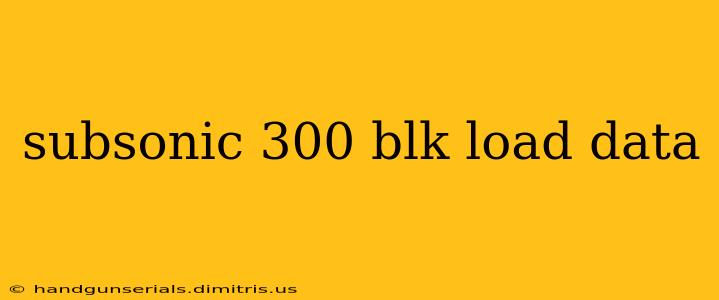The 300 Blackout cartridge has gained immense popularity among enthusiasts, particularly for its versatility in both supersonic and subsonic applications. This guide delves into the specifics of subsonic 300 BLK load data, emphasizing safety, accuracy, and responsible reloading practices. We'll cover various powder choices, bullet weights, and crucial considerations for achieving optimal performance. Disclaimer: Always prioritize safety. This information is for educational purposes only and should not be considered a substitute for professional reloading instruction. Consult your reloading manual and adhere to its guidelines before attempting any reloading.
Understanding Subsonic 300 Blackout
Subsonic ammunition, by definition, travels slower than the speed of sound (approximately 1125 feet per second or fps). This slower velocity results in a reduced sonic boom, making it ideal for suppressed applications where noise reduction is paramount. In the 300 Blackout platform, subsonic loads offer distinct advantages:
- Reduced Noise: The primary benefit is the significantly quieter operation, crucial for hunting, tactical applications, and recreational shooting where noise is a concern.
- Improved Accuracy (Potentially): Depending on the load, subsonic rounds can exhibit increased accuracy, particularly with suppressed firearms, due to the absence of a supersonic crack.
- Increased Effectiveness at Close Ranges: While not as effective at longer distances due to the reduced velocity, subsonic rounds retain sufficient energy for close-range applications.
Choosing the Right Components for Subsonic 300 BLK Loads
Creating effective subsonic 300 Blackout loads requires careful selection of components. Let's examine each:
1. Bullets:
Subsonic loads typically utilize heavier bullets, ranging from 190 to 220 grains. Popular choices include:
- Lead Core: Often more affordable, but require careful handling due to lead exposure.
- Lead-Free: Environmentally friendly and safer to handle but generally more expensive.
- Subsonic Design: Many manufacturers offer bullets specifically designed for subsonic performance, with features that optimize accuracy and stability at lower velocities.
The bullet's design significantly influences the load's overall performance. Look for bullets with a good ballistic coefficient for better accuracy and downrange energy retention.
2. Powders:
Selecting the right powder is crucial for subsonic loads. Several powders are known for their suitability in this application:
- Accurate Arms #9: A popular choice for its clean burning characteristics and consistent performance.
- Hodgdon Titegroup: Another widely used powder, known for its small particle size and good metering properties.
- Alliant Unique: A versatile powder that can work well in subsonic loads, but requires careful attention to charge weights.
Note: Always check your reloading manual for recommended powder charges for the specific components you're using. Never exceed the maximum recommended charge weight.
3. Primers:
Standard small rifle primers are generally suitable for subsonic 300 Blackout loads. However, always check your reloading manual for specific primer recommendations for your chosen powder.
4. Cases:
Use new or once-fired, properly cleaned and inspected brass cases for consistent results.
Developing Your Subsonic 300 BLK Load Data
Developing a reliable and accurate subsonic 300 Blackout load requires a systematic approach:
- Start Low and Go Slow: Begin with the minimum recommended charge weight specified in your reloading manual and gradually increase in small increments.
- Accurate Measurement: Use a precise powder scale to ensure consistent powder charges. Inconsistent powder charges can lead to erratic performance and potential safety hazards.
- Chronograph Testing: A chronograph is essential for measuring the velocity of your loads. This allows you to fine-tune your load to achieve the desired subsonic velocity and to ensure consistency.
- Accuracy Testing: After determining a safe and consistent velocity, test your loads at various ranges to evaluate their accuracy. This will help you identify the optimal load for your specific firearm.
- Record Keeping: Meticulously record all your load data, including powder charge, bullet weight, primer type, velocity, and accuracy results.
Safety First
- Always follow the instructions provided in your reloading manual.
- Never exceed maximum recommended charge weights.
- Always wear safety glasses and hearing protection when reloading.
- Store your ammunition properly.
- Handle ammunition with care.
This comprehensive guide provides a solid foundation for developing accurate and safe subsonic 300 Blackout loads. Remember, responsible reloading practices and adherence to safety guidelines are paramount. Happy reloading!

